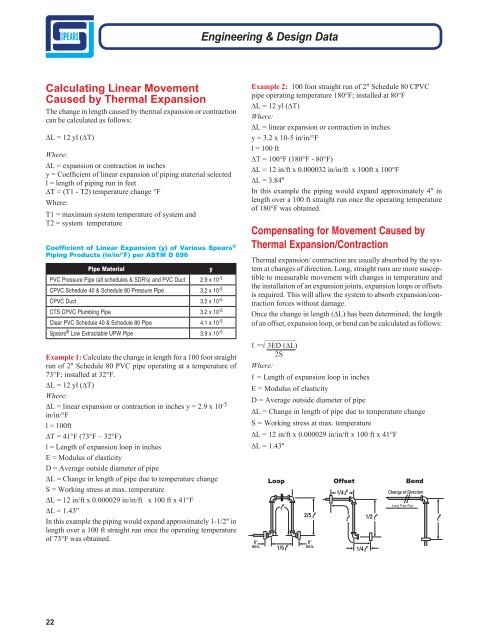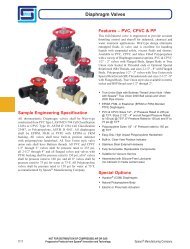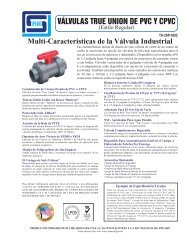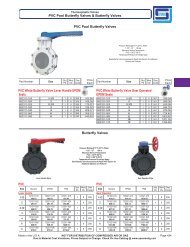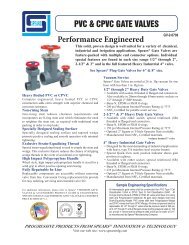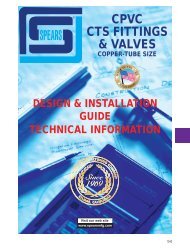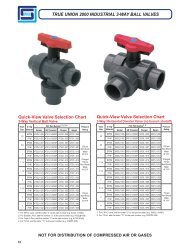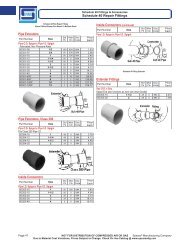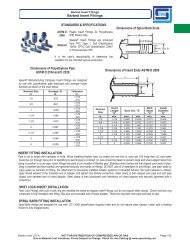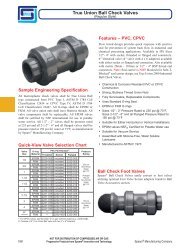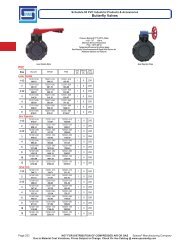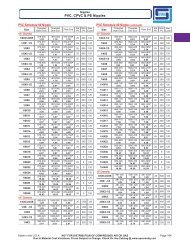If Preferred -- Download The Entire Booklet - Spears Manufacturing ...
If Preferred -- Download The Entire Booklet - Spears Manufacturing ...
If Preferred -- Download The Entire Booklet - Spears Manufacturing ...
You also want an ePaper? Increase the reach of your titles
YUMPU automatically turns print PDFs into web optimized ePapers that Google loves.
Engineering & Design Data<br />
Calculating Linear Movement<br />
Caused by <strong>The</strong>rmal Expansion<br />
<strong>The</strong> change in length caused by thermal expansion or contraction<br />
can be calculated as follows:<br />
∆L = 12 yl (∆T)<br />
Example 2: 100 foot straight run of 2" Schedule 80 CPVC<br />
pipe operating temperature 180°F; installed at 80°F<br />
∆L = 12 yl (∆T)<br />
Where:<br />
∆L = linear expansion or contraction in inches<br />
y = 3.2 x 10-5 in/in/°F<br />
l = 100 ft<br />
Where:<br />
∆T = 100°F (180°F - 80°F)<br />
∆L = expansion or contraction in inches<br />
∆L = 12 in/ft x 0.000032 in/in/ft x 100ft x 100°F<br />
y = Coefficient of linear expansion of piping material selected<br />
l = length of piping run in feet<br />
∆L = 3.84"<br />
∆T = (T1 - T2) temperature change °F<br />
In this example the piping would expand approximately 4" in<br />
Where:<br />
length over a 100 ft straight run once the operating temperature<br />
of 180°F was obtained.<br />
T1 = maximum system temperature of system and<br />
T2 = system temperature<br />
Coefficient of Linear Expansion (y) of Various <strong>Spears</strong> ®<br />
Piping Products (in/in/°F) per ASTM D 696<br />
Compensating for Movement Caused by<br />
<strong>The</strong>rmal Expansion/Contraction<br />
<strong>The</strong>rmal expansion/ contraction are usually absorbed by the system<br />
Pipe Material<br />
y<br />
at changes of direction. Long, straight runs are more suscep-<br />
PVC Pressure Pipe (all schedules & SDR’s) and PVC Duct 2.9 x 10 -5 tible to measurable movement with changes in temperature and<br />
CPVC Schedule 40 & Schedule 80 Pressure Pipe 3.2 x 10 -5 the installation of an expansion joints, expansion loops or offsets<br />
is required. This will allow the system to absorb expansion/contraction<br />
CPVC Duct 3.2 x 10 -5<br />
forces without damage.<br />
CTS CPVC Plumbing Pipe 3.2 x 10 -5<br />
Once the change in length (∆L) has been determined, the length<br />
Clear PVC Schedule 40 & Schedule 80 Pipe 4.1 x 10 -5 of an offset, expansion loop, or bend can be calculated as follows:<br />
Example 1: Calculate the change in length for a 100 foot straight<br />
run of 2" Schedule 80 PVC pipe operating at a temperature of<br />
73°F; installed at 32°F.<br />
∆L = 12 yl (∆T)<br />
Where:<br />
∆L = linear expansion or contraction in inches y = 2.9 x 10 -5<br />
in/in/°F<br />
l = 100ft<br />
∆T = 41°F (73°F – 32°F)<br />
l = Length of expansion loop in inches<br />
E = Modulus of elasticity<br />
D = Average outside diameter of pipe<br />
∆L = Change in length of pipe due to temperature change<br />
S = Working stress at max. temperature<br />
∆L = 12 in/ft x 0.000029 in/in/ft x 100 ft x 41°F<br />
∆L = 1.43"<br />
In this example the piping would expand approximately 1-1/2" in<br />
length over a 100 ft straight run once the operating temperature<br />
of 73°F was obtained.<br />
l = 3ED (∆L)<br />
2S<br />
Where:<br />
l = Length of expansion loop in inches<br />
E = Modulus of elasticity<br />
D = Average outside diameter of pipe<br />
∆L = Change in length of pipe due to temperature change<br />
S = Working stress at max. temperature<br />
∆L = 12 in/ft x 0.000029 in/in/ft x 100 ft x 41°F<br />
∆L = 1.43"<br />
6"<br />
min.<br />
Loop Offset Bend<br />
<br />
1/5<br />
<br />
2/5<br />
<br />
6"<br />
min.<br />
1/4<br />
Change of Direction<br />
<br />
1/4<br />
<br />
1/2<br />
<br />
Long Pipe Run<br />
<br />
22


